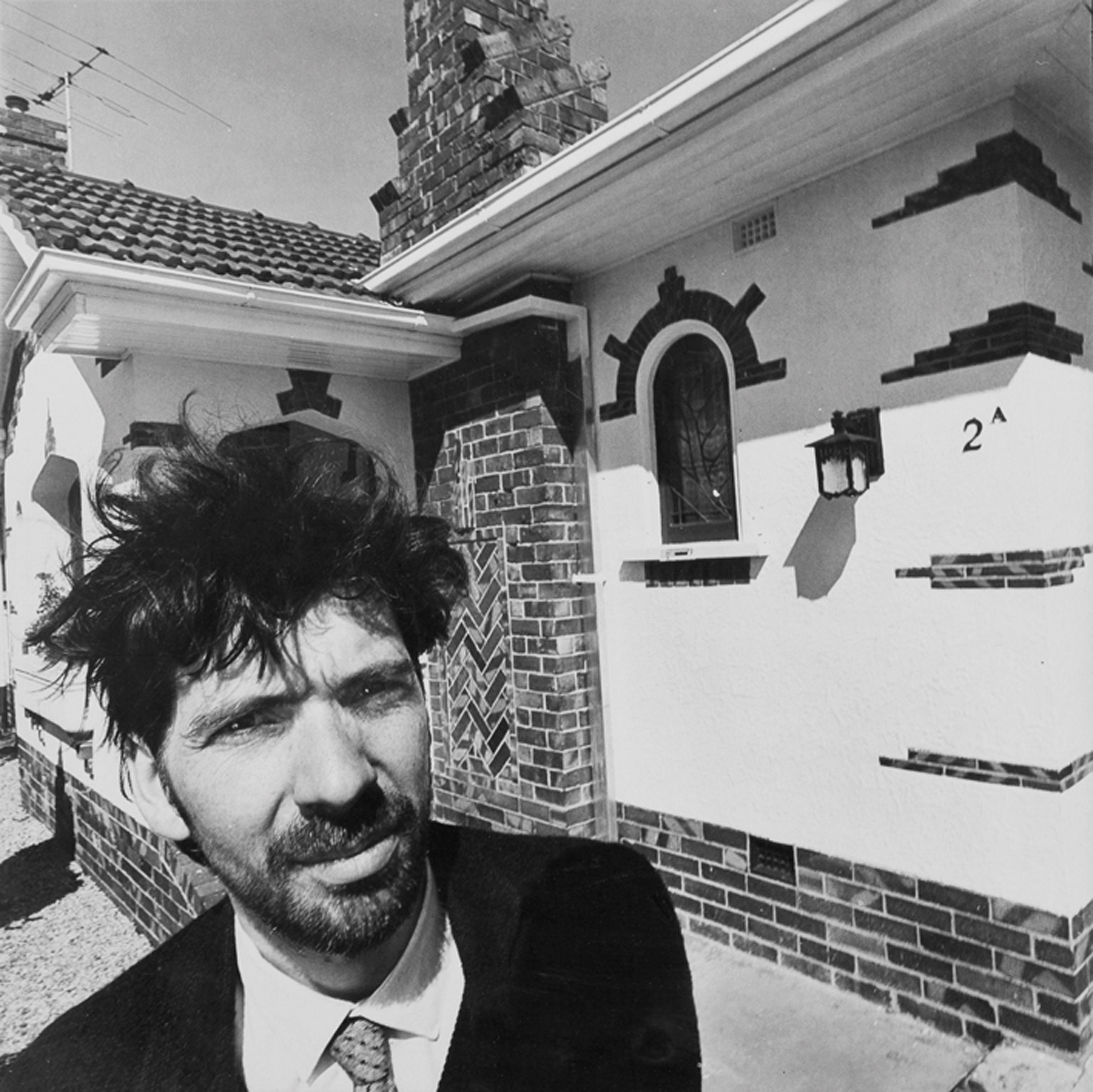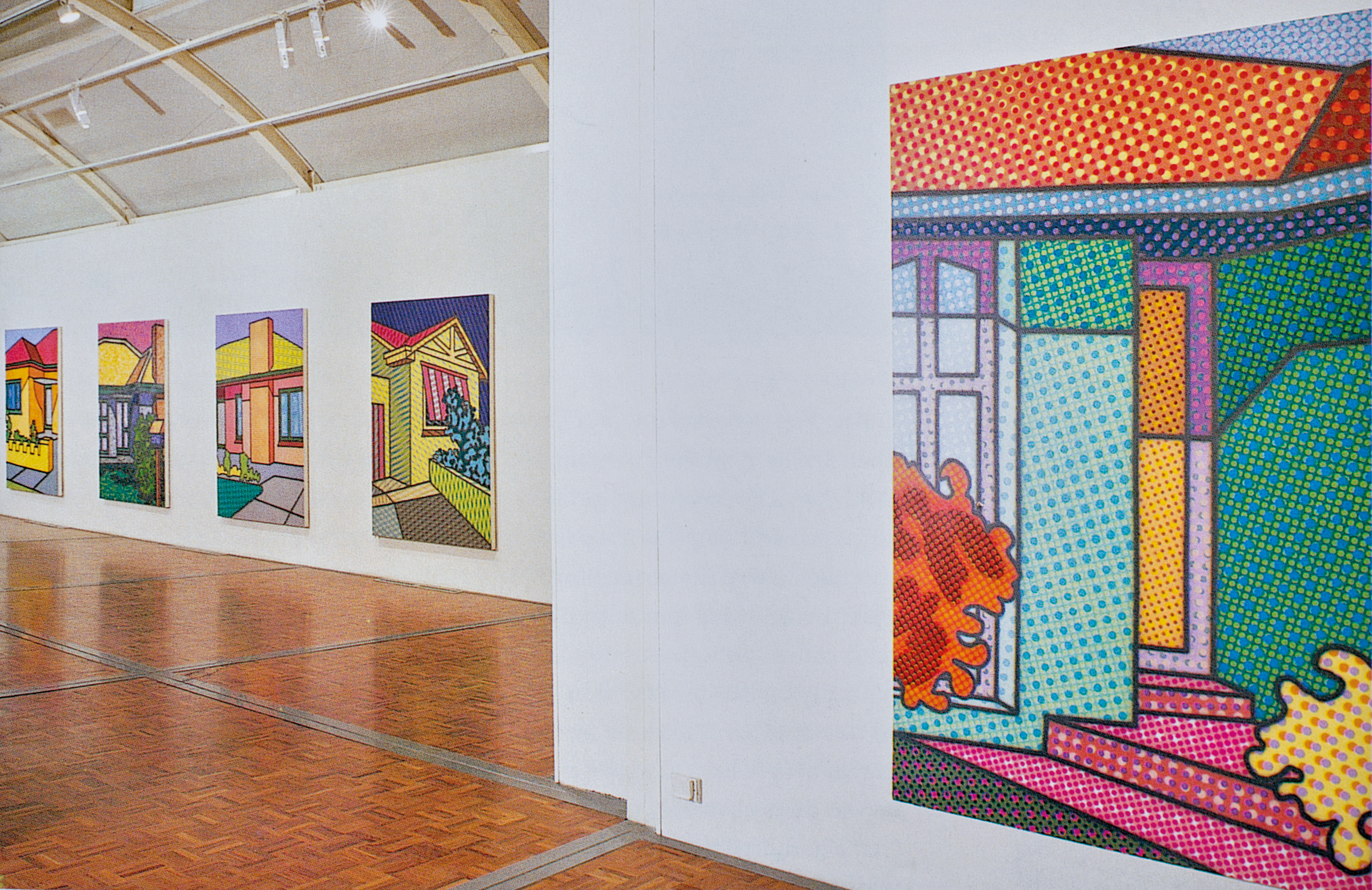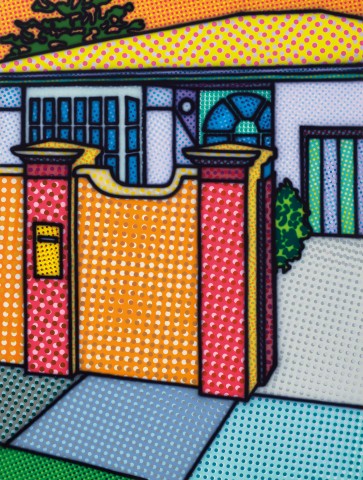HIGH FENCED, 1996
HOWARD ARKLEY
synthetic polymer paint on canvas
203.0 x 153.0 cm
signed and dated verso: Howard Arkley / 1996
Tolarno Galleries, Melbourne at Art Cologne, Germany
Gould Galleries, Melbourne, acquired from the above in 1996
Private collection, London, acquired from the above in 2000
Tolarno at Art Cologne, Art Cologne, Germany, 10 – 17 November 1996
Crawford, A., & Edgar, R., Spray: The Work of Howard Arkley, Craftsman House, Sydney, 1997, p. 130
Howard Arkley Online Catalogue Raisonné: [https://www.arkleyworks.com/blog/2009/11/24/high-fenced-1996/] (accessed 26/8/22)
High Fenced, 1995, synthetic polymer paint on paper, 160.0 x 121.0 cm, private collection, illus. in Crawford, A., and Edgar, R., Spray: The Work of Howard Arkley, Craftsman House, Sydney, 2001, p. 121
Howard Arkley

By the time Howard Arkley created High Fenced, 1996, he was beginning to receive international attention for his work, culminating in his representation of Australia at the 48th Venice Biennale in 1999. This classic Arkley of a squat suburban house for example, was exhibited by Tolarno Galleries in Germany in 1996 at the prestigious art fair Art Cologne, and his work was also included in group exhibitions in Korea and Singapore that same year.
Curated by Timothy Morrell, then Curator of Contemporary Australian Art at Queensland Art Gallery, Brisbane, Arkley’s The Home Show at Venice comprised three major bodies of work – Residential Subdivision, 1994 – 99, Fabricated Rooms, 1997 – 99, and Outside – Inside – Out, 1995, which filled, and seemingly reflected, the low-slung Australian beach house aesthetic of Paul Cox’s Pavilion.1 On entering the space, nine of the artist’s signature paintings of house exteriors were hung to form the imaginary streetscape of ‘Residential Subdivision’, brought together, as the exhibition unfolded, with the door-sized panels of Outside – Inside – Out, whose abstracted designs were inspired by the patterns of domestic security doors and fly screens.2 The exhibition culminated in the multi-panelled interior scene of Fabricated Rooms, with its characteristic use of explosive colour and its slightly off-kilter, tessellated sense of space, as the viewer moved from left to right, effectively entering, and exploring the rooms of a strangely empty home. As John Gregory has noted, ‘In conception and design, the show was the culmination of Arkley’s suburban enterprise, fulfilling a long-standing ambition to transform an entire exhibition into a stylised simulacrum of an Australian suburb …’3
Catalogue contributor Marco Livingstone, emphasising the psychedelic look and experience of Arkley’s paintings of suburban houses, described the artist’s images as ‘gloriously, elegantly, deliriously uncouth’ and as a ‘springboard for a heightened sensual and pictorial experience, born of fantasy, daydreaming and escapism.’4 Clearly written with the aim of establishing a sense of connection, recognition and understanding between an international art audience and the artist’s quintessentially Australian images, Livingstone also highlighted Arkley’s connection to familiar Pop artists such as Patrick Caulfield and Richard Hamilton. However, given the positive reception of the exhibition on this global stage, it is fair to assume that an audience well-versed in postmodernism easily recognised and responded to the equivalence of Arkley’s high- and low-brow sources, to his investigation of formal concerns with colour, line and pattern, to his experimental nature, and to his deft handling of his materials. As Arkley’s first wife, artist Elizabeth Gower has remarked: ‘He had such control of the airbrush, it was like the sixth finger on his hand. His concentration was intense. One can only marvel at his ability to sustain it.’5
As the 2011 acquisition by the State Library of Victoria of the substantial Howard Arkley Archive has demonstrated, Arkley was a prodigious collector of references and source material. Clippings of images from magazines, and the artist’s own photographs, collages, doodles and notes fill the pages of countless notebooks, revealing the artist’s seemingly endless capacity for creative juxtaposition and reinvention as forms and patterns appear and are re-worked in different guises, across his oeuvre. Figuration and abstraction sit side by side, and his abiding interest in the construction and presentation of our lives through ‘the home’ is treated with a lightness of touch that has at times been misconstrued as either critique or indifference. As Arkley once said to his long-term studio assistant and fellow artist Constanze Zikos, ‘make what you know, make what you understand.’6 Arkley recognised that life in the suburbs was the reality of most Australians, and he knew them from firsthand experience, having grown up in Surrey Hills and after living in the inner-city for many years, moving to the Melbourne suburb of Caulfield with his partner Alison Burton in 1991.
Howard Arkley Venice Biennale

Arkley often based paintings like High Fenced on real estate advertising images, where properties literally put on their ‘best face’ for purchase; their carefully constructed sketches or photographs framed to obscure less attractive features and delete any unnecessary distractions. The unusual angles and compressed space of the work mirror and exaggerate this effect, only allowing the audience a view of the property over the top of the imposing fence and physical access through the slice of driveway to the right of the composition. Howard Arkley painted his first house painting in 1983 and remained captivated by this embodiment of the suburban dream until his untimely death in July 1999, just one month after the opening of the Biennale. As he enthused: ‘Ordinary houses are full of pattern... the different bricks on the different houses, and the pattern between the gutter, the nature-strip, the footpath, then you have the fence, then you have the lawn, the house, the tiles, then you have the beautiful sky... and I missed the bushes in between... it’s rich.’7
1. The Australian Pavilion was constructed as a temporary building in 1988 to house the exhibition Arthur Boyd: Paintings 1973 – 1988. Australia was allocated the then last site available in the Giardini della Biennale and is now one of only 29 national pavilions within the Biennale Gardens. Despite being a temporary structure, prefabricated in Australia using local materials and shipped to Venice for construction, the Pavilion was used for 26 years.
2. Livingstone, M., ‘Some Kinds of Love: Howard Arkley’s Urban Suburban Environment’, Howard Arkley: The Home Show, Australian Pavilion, 48th Venice Biennale 1999, ex. cat., Australia Council, Sydney, 1999, p. 9
3. Gregory, J. ‘Howard Arkley: The Home Show, Venice Biennale, June – November 1999’, Arkley works: https://www.arkleyworks.com/blog/2009/11/21/howard-arkley-the-home-show-..., accessed 17 October 2022
4. Livingstone, M., op. cit., p. 8
5. Gower, E., ‘Elizabeth Gower statement’, 2006, email to Victoria Lynn, October 2015 in Fitzpatrick A. & Lynn, V., Howard Arkley and Friends, Tarrawarra Museum of Art, Healesville, 2015, p. 43
6. Zikos, C., conversation with Victoria Lynn, July 2015 in Fitzpatrick A. & Lynn, V., op .cit., p. 59. Constanze Zikos was Arkley’s studio assistant from 1984 to 1994 and a postgraduate student of Arkley’s at the Victorian College of the Arts, Melbourne from 1984 to 1986.
7. Gregory, J., Carnival in Suburbia: The Art of Howard Arkley, Cambridge University Press, Melbourne, 2006, p. 9
KELLY GELLATLY
